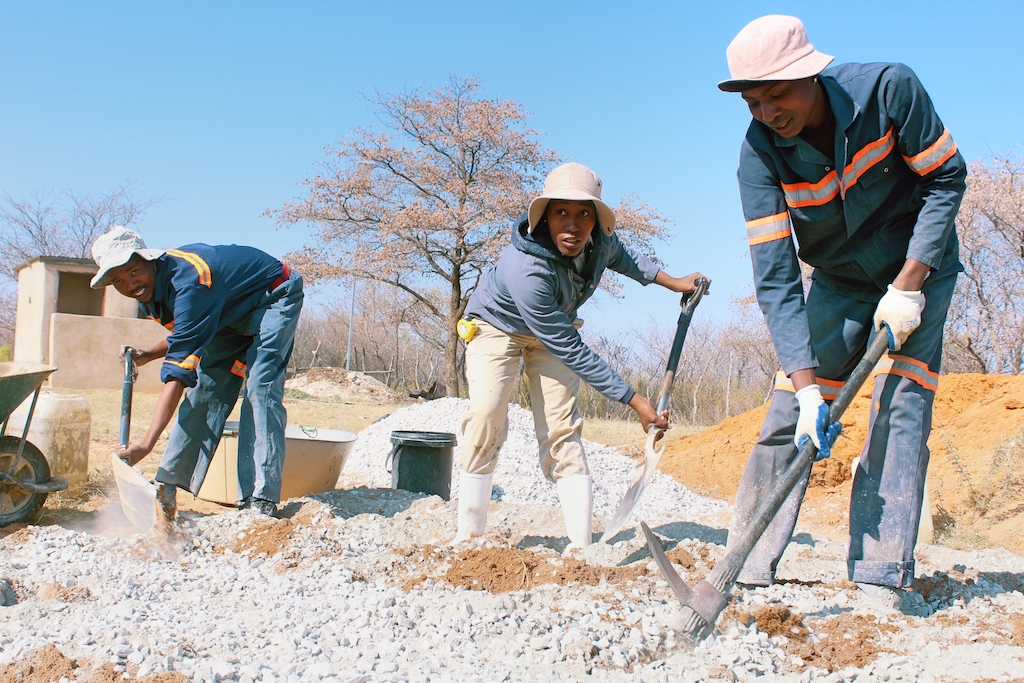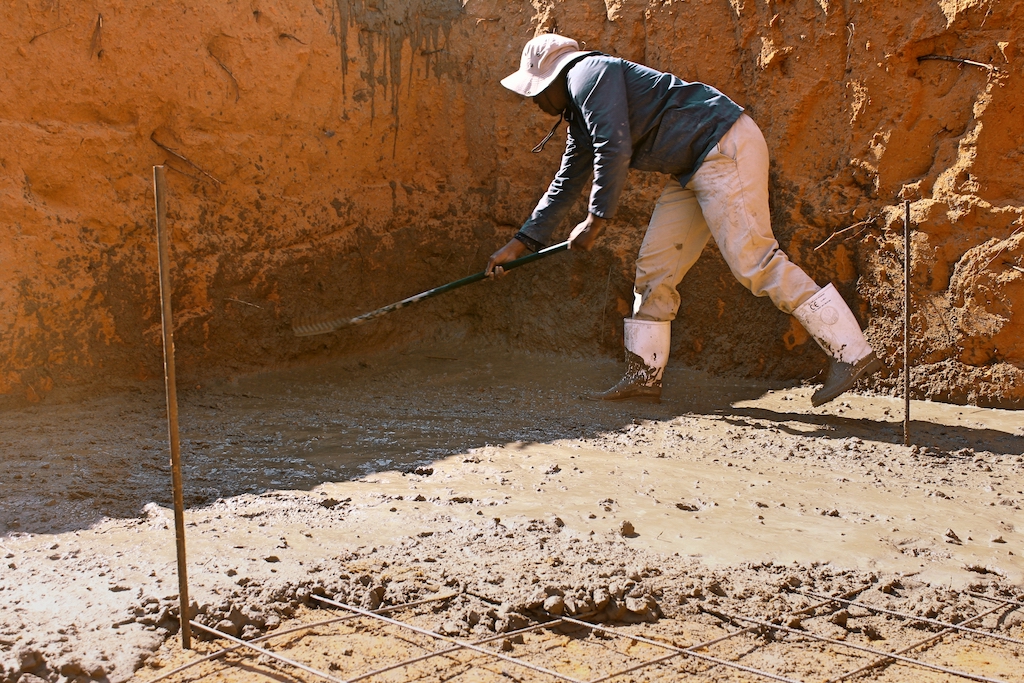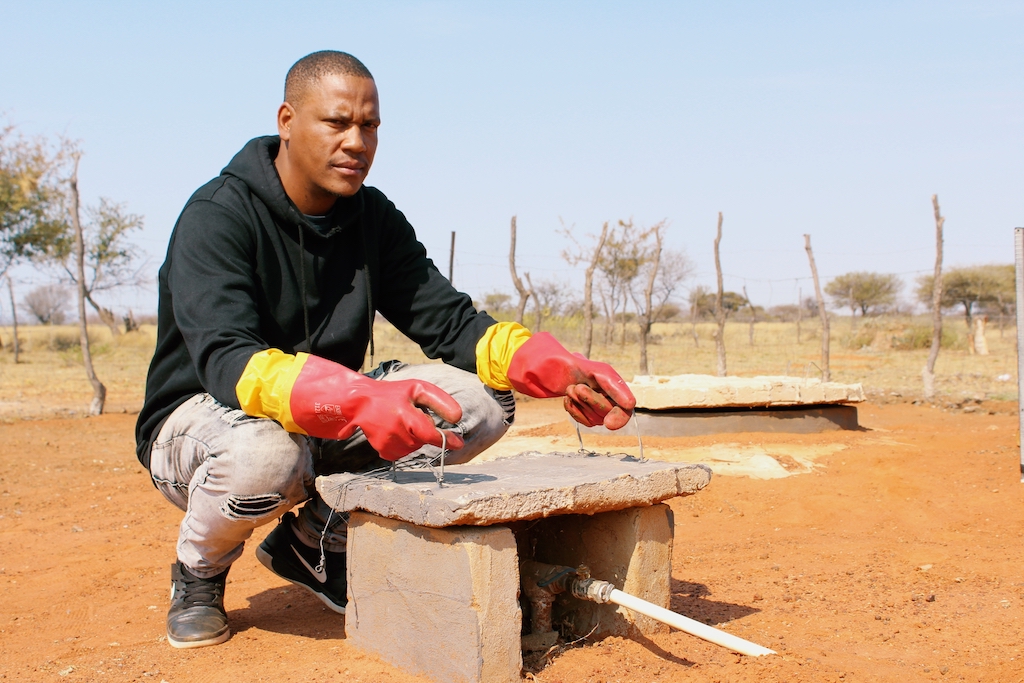
06 Oct Biogas power raises hot air in Botswana
An ambitious public-private biogas project needs to be scaled up if it is to contribute to Botswana’s renewable energy targets by 2030. Sharon Tshipa investigates

Trained mason Atamelang Matale (centre) and two colleagues mixing concrete needed to build a ‘mammoth’ biogas digester. Photo © Sharon Tshipa
“We are building a mammoth!” says Atamelang Matale, her eyes in a happy dance. “This is the biggest biogas digester I am constructing to date.”
Her voice is loud. It rises above the din of splashing water, the grating and clanking of shovels scooping and throwing concrete mix into a water-filled wheelbarrow. The end result is a grey porridge subsequently dumped into a digester pit pre-laid with welded wire mesh.
The 29-year-old Matale is a biogas digester mason trained through a project in Botswana funded by the Global Environment Facility (GEF) and the United Nations Development Programme (UNDP).
The project, launched on January 20 2017 and wrapped up in January 2022, sought to promote the production and use of biogas as an environmentally friendly source of energy for farms, households and institutions that produce or have access to agro-waste.

Inside the 30m3 digester that Atamelang Matale and her colleagues are constructing in Betesankwe Village. Photo © Sharon Tshipa
Biogas digester masons
Matale has constructed 19 digesters that process agro-waste, such as cow dung and chicken litter, to produce biogas – directly used for cooking, heating and lighting – across south-eastern Botswana. The 30m3 digester she is currently constructing in Betesankwe Village in partnership with three colleagues is her 20th.
“The digesters I built before only ranged between six, 10 and 20 cubic metres in size. This is huge, so we will be camping out here for the three weeks it will take to complete it,” she says.
Being a mason has made her financially independent, she says, despite the gender discrimination that prevails in the male-dominated construction industry.
Since 2018, 70 biogas digester masons have been trained by the project in six vocational training centres. Only 29% of them are women, even though the project originally aimed to achieve gender equity. The UNDP’s final project report admits that “while gender was a consideration in project design, the project itself has not made sufficient progress to determine any substantial gender impacts”.
“People tend to look down on us, forcing us to work twice as hard to prove that we are capable,” says Matale.
Tracey Rukero, a young female biogas digester mason who completed her training last year and has since constructed four digesters, shares similar sentiments: “Many people don’t think we can do the job,” she says.
Energy transition
The two women have mixed views on whether the funded biogas project will contribute meaningfully towards Botswana’s energy transition ambition to have 15% of the Southern African country’s electricity supply come from renewable energy by 2030 – as opposed to the current 2.4% estimated contribution.
Speaking at a high-level event on climate change in Kigali, Rwanda, in June this year, President Mokgweetsi Masisi reaffirmed Botswana’s commitment to a gradual transition from over-reliance on coal for electricity generation. He drew attention towards the need to increase the country’s share of renewable energy, and significantly improve the efficiency of the energy system.
The government regards the development of a sustainable and commercial biogas sector as a key mechanism for achieving the reduction of harmful greenhouse gas (GHG) emissions and effectively managing agricultural waste, especially from the beef and cattle industry.
In its first nationally determined contribution to cut emissions and adapt to climate impacts, Botswana pledged to reduce its emissions by 15% by 2030, taking 2010 as the base year. The base-year emission estimation was 8,307Gg of CO2 equivalent. Botswana’s GHG emissions make up 5% of Africa’s total 3.8% global emissions, according to the country’s Climate Change Policy.
For this commitment to be realised and for biogas to make a plausible contribution to the reduction of GHG, Rukero and Matale’s experiences point to the urgent need for mindset change among citizens.
“The project is not making much of an impact because some of the beneficiaries are failing to feed and take care of their biogas digesters,” explains Rukero, who adds that some of the beneficiaries feel that the renewable energy alternative has a bad smell, and producing it means handling dirt.
Matale, on the other hand, suggests that the biogas project is a success already and can go far as it has brought financial relief to Batswana because they are using renewable energy resources to generate energy that is clean and free.
Matale agrees that there is need for attitude change among some beneficiaries: “During the construction process and at handover, beneficiaries are taught how to feed and operate the digesters. But once the digesters run out of energy, they don’t feed the digester with cow dung or do any of the things we would have taught them in order to keep the digester functional. Rather, they call us and say that our digesters are no longer working,” she explains.
According to the project’s final report, 110 small-scale digesters had been installed and the majority of them were operational by mid-2021, with an estimated 80m3 per day of biogas produced. Assuming daily feeding and usage of all the digesters, this would translate to 7,227-million m3 per annum, the report states.
However, the project did not achieve its aim of feeding 350,000MWh into the electricity grid because it lacked the funding to construct the medium- to large-scale digesters needed to do this, according to the report.

Goemeone Kagiso and his wife use their digester for cooking, lighting and heating water. Photo © Sharon Tshipa
Biogas beneficiaries
At a cattle post settlement called Gatuma located near Mmathethe Village, Goemeone and Mpho Kagiso have over the past year embraced biogas and are enjoying more than just the financial relief that Atamelang Matale alludes to.
“We no longer have to go to bed hungry when it is raining heavily or is very windy. We use our biogas for cooking and lighting. We also warm up water for bathing,” says Goemeone Kagiso, whose life is centred around livestock rearing and crop farming.
He and his wife own 15 cattle, five pigs and a wide range of poultry. From these he collects between five and to 40 litres of waste a day that he feeds into his 10m3 digester.
“It’s easy for us to collect more cow dung around this farming area if we need to,” he explains. All he has to do is ensure that the cow dung he gathers does not include soil elements which are not biodegradable, as these would block the digester.
Kagiso is one of the 231 beneficiaries of the biogas project. The initial aim was to construct 1,000 small-scale digesters but this target was reduced to at least 200 due to time constraints.
Tumisang Ruda, an energy engineer at the Department of Energy, says the beneficiaries are mostly female – at 52.8% – and are spread within the Kweneng (101), Kgatleng (42), Southern (58) and South East (30) districts. These districts cover less than 25% of the country’s landmass, yet their main landfill sites contributed almost half of the total municipal solid waste collected by landfill in 2017 – 107,768 tonnes of 224,320 tonnes, according to Statistics Botswana.
To become a beneficiary, Goemeone Kagiso had to apply and invest P3,500 (USD271) towards buying construction materials for the digester. The implementing organisations covered labour expenses.
Another beneficiary, the currently unemployed 29-year-old Kutlo Sedimo, says he spent P40,000 (USD3,096) on materials needed for the installation of a 30m3 digester that was completed in May last year.
Besides time constraints, the UNDP report suggests that this requirement for potential users of the small-scale biogas digesters to invest in the installation of the technology negatively affected the uptake as some farmers were too poor to afford it while others would not invest in a novel technology.
The biogas project’s final report posits that there were only 15 biogas digesters in the country when this project was rolled out. What made it even harder for the project to generate interest in biogas, the report notes, was “the fact that many agricultural and energy programmes in Botswana are free or are supported by incentives, a factor not considered in project design”.
Project financing
Data in the project’s final report shows that the biogas project was largely made possible by US$2,632-million in funding pledged by the Global Environment Facility and $200,000 pledged by the UNDP.
At project design, co-financing (in cash and in kind) amounting to $19,316-million had been committed to the project by the government and parastatal bodies such as Botswana Innovation Technology & Research Institute (BITRI), Department of Waste Management and Pollution Control (DWMPC), Botswana Development Cooperation (BDC), Botswana Meat Commission (BMC) and the Ministry of Environment, Wildlife and Tourism (MEWT).
By March 2022, total expenditure on the project was $2,216-million, the final report shows. No government funding was forthcoming due to the fact that the government had no money to invest in it, according to the Department of Energy’s public relations officer, Kebolokwe Khumoetsile.

A working biogas digester being fed cow dung and other livestock waste at Gatumo Cattle Post. Photo © Sharon Tshipa
Private sector
The project has increased the number of biogas digesters in the country by at least 231 to date, and resulted in the development of an Integrated Waste Management Bill and Biogas Standards – strategic frameworks that are still to be adopted.
However, Obuile Morewane, chief executive of Bio-watt Botswana – a company that designs and sells biogas systems to communities largely in rural areas – believes that biogas will not be a major contributor to the energy mix the government has in mind for 2030.
“We are still lagging behind in standards and regulations on biogas systems. Solar energy will be the major contributor, this is also confirmed by the Integrated Resource Plan,” he says.
Botswana’s current installed energy capacity of 890MW is dominated by coal resources at 99%. The Integrated Resource Plan, which aims to facilitate Botswana’s transition from reliance on fossil fuels to clean energy, was approved in August 2020. Its implementation is supported by a USD1-million grant from the Sustainable Energy Fund for Africa, managed by the African Development Bank. Among other outputs, the grant contributes to the introduction of at least 50MW of wind and 100MW of solar PV capacity by 2030.
Morewane notes another shortcoming of the biogas project is the fact that it left out the private sector. According to the final UNDP project report, in terms of the private sector, the project mostly engaged with financial institutions in Botswana on financing biogas digester construction.
“Without the full engagement of the private sector, technology implementation will stall, as is the current situation,” he says.
While applauding the government for inspiring the uptake of biogas, Morewane advises the government and other stakeholders to leave the implementation and commercialisation of the biogas project to the private sector and to focus on efforts they have efficiently undertaken, such as raising awareness and influencing mindset change.
The final project report acknowledges that “a conducive policy environment for the private sector needs to be in place for the biogas market to develop”, and that “opportunities for partnerships with the private sector should be explored in detail at the design stage and awareness built around their potential role, as a focus on state-owned institutions may limit uptake of market opportunities”.
Questions addressed to the Ministry of Environment, Natural Resources Conservation and Tourism, and to the Department of Energy, about their plans to engage the private sector in the goal to get 15% of the country’s energy mix from renewables by 2030 remained unanswered at the time of publishing.
Waste policy
To ensure a meaningful contribution by biogas, Morewane highlights the need to review the Integrated Waste Management Policy in order to reclassify organic waste such as cow dung and chicken litter from being waste that ends up in the landfill to useful raw material.
Though the cattle population in the country is dropping, the UNDP project suggests the sector still produces a vast amount of agro-waste for use in biogas digesters. In 2020 Statistics Botswana reported a drop in the traditional sector cattle population – from 2,468-million in 2001 to 935,000 in 2019 – mostly attributed to extreme drought caused by climate change.
There is no data on the quantity of cow dung generated nationwide annually. However, a 2020 report by Statistics Botswana shows that 224,320 tonnes of solid waste were disposed at various landfills – comprising 8,169 tonnes of garden waste, 2,495 tonnes of poultry waste and 117,191 tonnes of household waste.
The use of both household waste and cow dung in different ratios was found to produce significant biogas yields in a 2018 study by Professor Kevin Nwaigwe from the Department of Mechanical Engineering at the University of Botswana and other scholars.
Morewane says Batswana view biogas as an energy source that can save them money, but there needs to be a mindshift away from cultural beliefs that are still hindering the development of biogas. “There are still people who believe that meals prepared using firewood taste better than those prepared using biogas,” he says.
Sharon Tshipa is a multimedia journalist based in Botswana. This investigation was completed with the support of the Oxpeckers Investigative Environmental Journalism #PowerTracker project and the Centre for Investigative Journalism’s Open Climate Reporting Initiative. It was co-published by the Mail & Guardian here, by Mmegi here, by CAJ News here and by Xinhua News here
